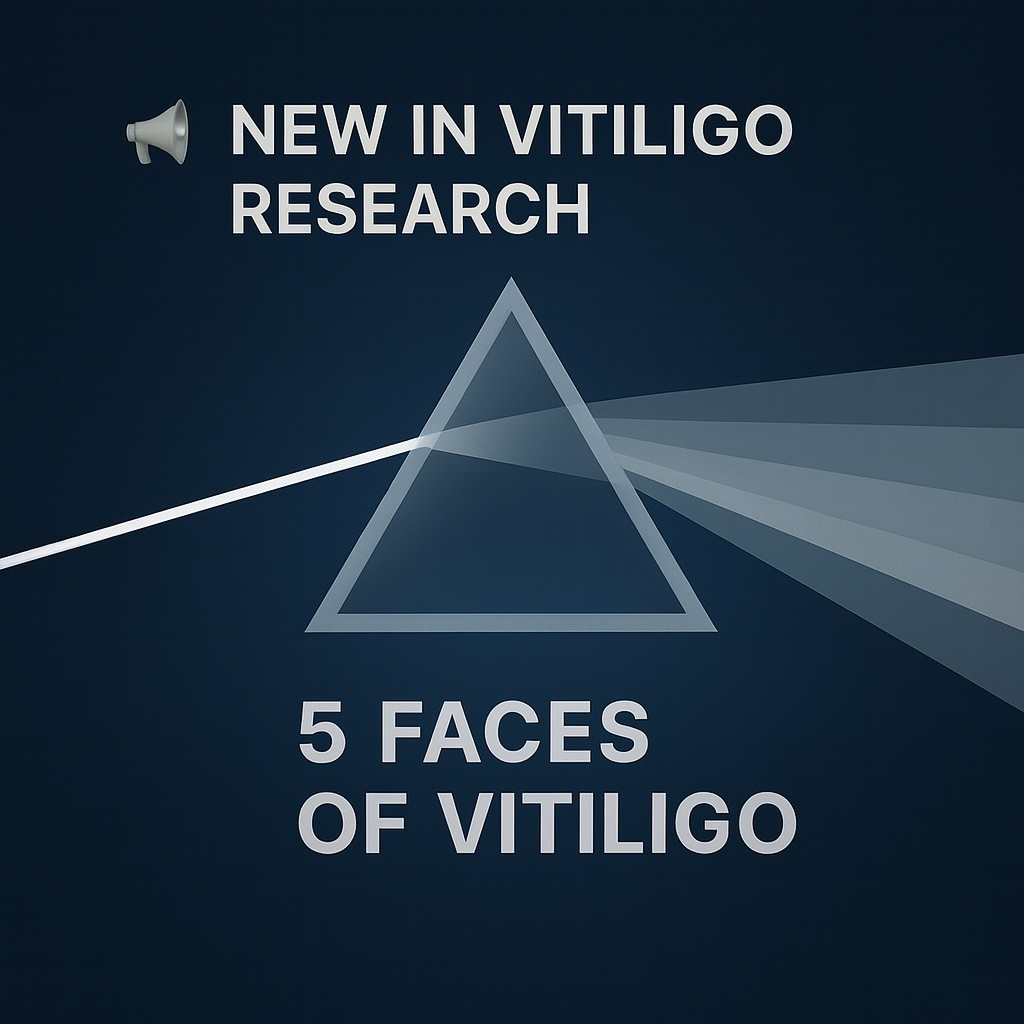New
Rethinking Vitiligo – Five Distinct Faces of a Complex Disease
For years, vitiligo was treated like a single, monolithic condition. You either had segmental or non-segmental disease, end of story.
But real life has never fit neatly into those boxes. A recent study in the Journal of the European Academy of Dermatology and Venereology (paywall) finally cracks that old frame. Using machine learning on nearly 400 patients, researchers mapped out five distinct “faces” of non-segmental vitiligo. It’s less about where the patches show up and more about how the disease behaves — and that’s a game-changer.
Why Stratify at All?
Old classifications looked only at distribution — segmental, generalized, focal. Easy to teach, not so useful in practice. They missed the big picture: age of onset, speed of progression, how patients respond to therapy. This new model digs deeper, clustering patients by clinical behavior instead of surface geography.
The Five Phenotypic Clusters
1. Highly Active Vitiligo (12.5%)
Relentless activity defines this cluster. Nearly all patients showed trichrome lesions (96%) and confetti depigmentation (80%), often triggered by trauma (Koebner type 2B). Moderate skin involvement and frequent itch were common. Most patients ended up needing intensive treatment, from steroid minipulses to narrowband UVB. Because of their high risk of rapid progression within 3-6 months, early and aggressive management is essential.
2. Mild Vitiligo (31.8%)
Here, disease remained limited with minimal activity, often restricted to the face and acral areas. Topical creams were usually sufficient, but more than half of these patients (52%) stopped follow-up — likely reflecting either a low sense of urgency or frustration with treatment.
3. Extensive Vitiligo (12.3%)
Long-standing, resistant disease marks this group. Patients had widespread involvement, an average duration of nearly 25 years, and the highest frequency of leukotrichia (26.5%). Roughly half received systemic therapy, though results were limited. Once hair turns white, pigment is rarely regained, making this subgroup one of the hardest to treat.
4. Moderate to Severe Type 2A Koebner Vitiligo (13.3%)
Lesions clustered at friction-prone areas — elbows, knees, waistline — in a pattern reminiscent of psoriasis. Disease extent was moderate, though activity levels stayed low. Most were managed with topical therapies, sometimes with added phototherapy.
5. Mild Type 2A Koebner Vitiligo (30%)
The largest cluster showed localized lesions at Koebner sites and acral regions, with low activity and moderate K-VSCOR values. Halo nevi appeared in nearly a quarter of patients (24.2%), which may help doctors unlock new clues about how vitiligo develops. Most did well with conservative treatment — creams, occasionally phototherapy.
Why This Matters
- For clinicians, the message is simple: not all vitiligo is created equal. Some patients need intensive treatment from day one; others can take a slower course.
- For researchers this means outcome measures should reflect phenotype — not just the percentage of pigment lost — so trials capture what really matters in each subgroup.
- For patients, this means we’re finally seeing research that mirrors what they’ve always known — vitiligo behaves differently from person to person.
- For advocates, it strengthens the case for broader access to advanced drugs like topical JAK inhibitors for those with the highest risk of rapid progression.
Digital Medicine and What’s Next
The fun part? This wasn’t guesswork. The team used factor analysis and consensus clustering — fancy names for letting an algorithm sort the data without human bias. It’s a sign of where dermatology is heading: AI models, real-world data, multi-omics all feeding into a future of precision dermatology.
Of course, gaps remain. The study skipped VASI scoring and didn’t touch on quality-of-life — things patients care about as much as pigment. That’s where advocacy comes in: pushing for research that measures not just the skin, but the person inside it.
Beyond the Clinic
For patients, this means fewer vague answers and more clarity. Instead of “vitiligo is unpredictable,” doctors can start saying, “Given your phenotype, here’s what’s most likely to happen.”
That shift alone changes how people engage with their care and their community.
Final Word
Vitiligo was once painted with one brush. Today, with five phenotypes on the map, the canvas looks richer — and the path to precision care clearer.

Yan Valle
Professor h.c., CEO VR Foundation | Author A No-Nonsense Guide To Vitiligo
Suggested reading:
- Sixty Years of Vitiligo Research: Where We’ve Been and Where We’re Going
- Biologic Therapies for Vitiligo: A New Era of Hope
- 📌 Vitiligo Drug Pipeline Analysis and Market Insights
Listen to podcast Deep Dive In Vitiligo:
- Vitiligo Pipeline 2025: Winners, Watchlist, What’s Next (Ep. 41)
- Sixty Years Of Vitiligo Research — Where Are We Now and What Comes Next? (Ep. 35)
Our podcast Deep Dive In Vitiligo is available on all digital platforms, like Apple Podcasts, Spotify, Amazon, YouTube Music, Podcast Addict, iHeart and elsewhere.

FAQOther Questions
- Can Ginkgo Biloba help with vitiligo?
Ginkgo Biloba offers a promising, simple, and relatively affordable option for managing vitiligo. Known for its anti-inflammatory, immunomodulatory, and antioxidant properties, ...
- Vitiligo and Pregnancy
Pregnancy with vitiligo? The good news: vitiligo itself doesn’t make pregnancy unsafe. Most women stay stable (some even improve), though flares can pop up after birth — usually...
- Will it spread?
Vitiligo's progression and response to treatment can vary significantly among individuals, making it a particularly unpredictable skin condition. Based on the VALIANT study, her...
Though it is not always easy to treat vitiligo, there is much to be gained by clearly understanding the diagnosis, the future implications, treatment options and their outcomes.
Many people deal with vitiligo while remaining in the public eye, maintaining a positive outlook, and having a successful career.
Copyright (C) Bodolóczki JúliaBy taking a little time to fill in the anonymous questionnaire, you can help researchers better understand and fight vitiligo.
